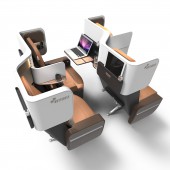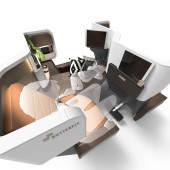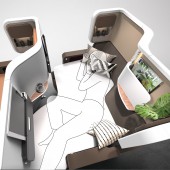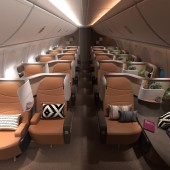Butterfly Aircraft Seat by James Lee |
Home > Winners > #88997 |
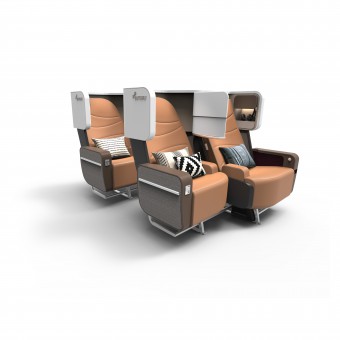 |
|
||||
| DESIGN DETAILS | |||||
| DESIGN NAME: Butterfly PRIMARY FUNCTION: Aircraft Seat INSPIRATION: Demand is never constant, yet aircraft configurations are usually fixed. As a passenger, I often noticed wasted space on flights. Sometimes economy class is overbooked but business class is rather empty, sometimes the opposite occurs. And as someone who have once worked in an airline, I reckon the need for an adaptable seat that can react to changing market demand. The implication to the operational efficiency is transformative, much like a caterpillar transforming into a butterfly. UNIQUE PROPERTIES / PROJECT DESCRIPTION: Butterfly is a flexible aircraft seating system that allows instant transformation between premium economy and business class flatbed suites. The concept enables operators to adjust their cabin configuration to real-time market changes, allowing them to make efficient use of valuable floor-space, increase aircraft utilization and reduce business risk. It also gives passengers new ways to configure their own space, whether it is a cosy private retreat or a family-friendly social space. OPERATION / FLOW / INTERACTION: Each Butterfly suite is made of two reclining seats staggered relative to each other. When both seats are used, they are sold as premium economy class. Airline crew can flip the window seat over to form a side couch, which turns it into a long-haul business class suite for one passenger. When the aisle seat is flipped over as well, it forms a flat surface continuous with the side couch, which together forms a large sleeping surface long enough for a passenger to lie flat diagonally. PROJECT DURATION AND LOCATION: The project started in 2014 in Hong Kong and is still ongoing. FITS BEST INTO CATEGORY: Vehicle, Mobility and Transportation Design |
PRODUCTION / REALIZATION TECHNOLOGY: - SPECIFICATIONS / TECHNICAL PROPERTIES: - TAGS: Aircraft Seating, Flexibility, Transform, Airline, Business class, Premium Economy RESEARCH ABSTRACT: - CHALLENGE: - ADDED DATE: 2019-06-30 14:18:54 TEAM MEMBERS (3) : James Lee, Vincent Tam and Lars Rinne IMAGE CREDITS: James Lee, 2019. PATENTS/COPYRIGHTS: Patented |
||||
| Visit the following page to learn more: https://www.butterflyseating.com | |||||
| AWARD DETAILS | |
 |
Butterfly Aircraft Seat by James Lee is Winner in Vehicle, Mobility and Transportation Design Category, 2019 - 2020.· Read the interview with designer James Lee for design Butterfly here.· Press Members: Login or Register to request an exclusive interview with James Lee. · Click here to register inorder to view the profile and other works by James Lee. |
| SOCIAL |
| + Add to Likes / Favorites | Send to My Email | Comment | Testimonials | View Press-Release | Press Kit |
Did you like James Lee's Vehicle Design?
You will most likely enjoy other award winning vehicle design as well.
Click here to view more Award Winning Vehicle Design.


